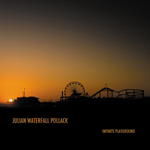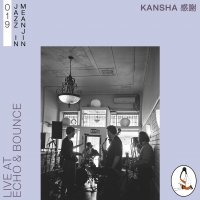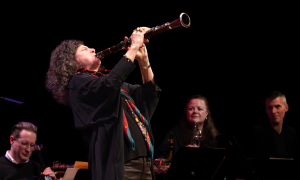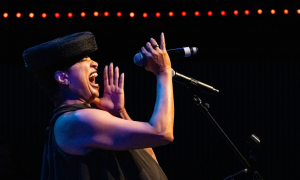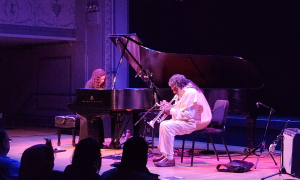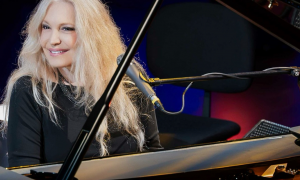Home » Jazz Articles » Live Review » Norwegian Road Trip, Part 2: Kongsberg Jazz, July 9-10, 2010
Norwegian Road Trip, Part 2: Kongsberg Jazz, July 9-10, 2010
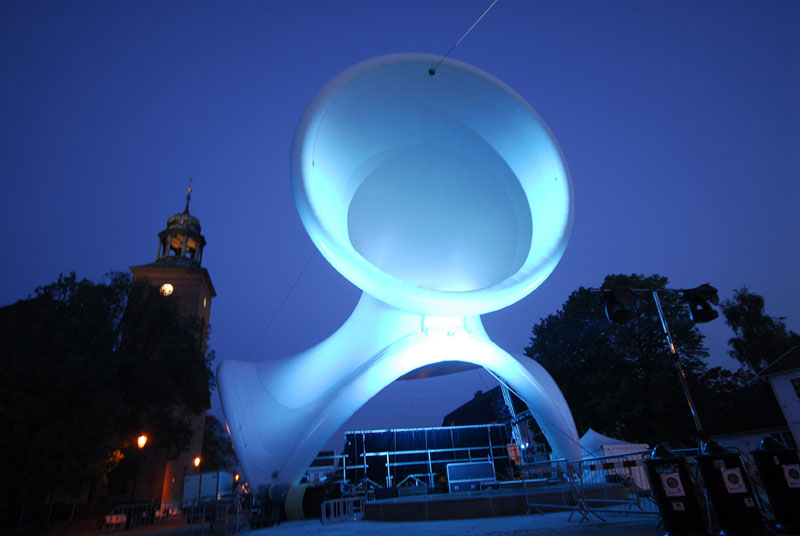
[Editors Note: From July 6 to July 26, 2010, All About Jazz Managing Editor John Kelman will travel throughout Norway to cover both the Kongsberg Jazz Festival (also participating in Silver City Sounds) and Molde Jazz. He'll also spend a week between the two famous festivals in Oslo, where he'll check out the scene, talk to musicians and labels, and visit the legendary Rainbow Studio for a look around and an interview with engineer Jan Erik Kongshaug, who has participated in hundreds of ECM recordings. He'll publish every second or third day, so be sure to follow him as he goes from the east coast to the west, in search of Norwegian artists known and unknown].
Each morning, before heading back to town to catch the day's shows at the Kongsberg Jazz Festival, Silver City Sounds sponsors a brief program at the hotel in Storaas, about 20km outside. The majority of the sessions were sponsored by Music Export Norway, and organization devoted to spreading the word about Norwegian culture to the world. With attendees from all over Europe and farther abroad, it was an ideal opportunity to also demonstrate the country's commitment to ensuring that archival material doesn't get lost over the years. It's hard to imagine that, before the 1960s, Norway was an entirely different country. The discovery of oil may have facilitated many things—including the country's remarkable infrastructure—but improvements to roads, rail, education and health care are not particularly revolutionary or unique. How the country applies some of that money to the perpetuation of culture at a level virtually unheard of—especially in towns the size of Kongsberg—most definitely is.
For a specific example, one only need look as far as a recent AAJ interview with Kristiansand resident, Punkt Festival co-Artistic Director and live sampler Jan Bang, who describes a unique program called Cultiva, where interest on funds earned through the sale of excess electricity have been used to provide startup funding for festivals like Punkt, not to mention making it possible to build a new arts center to replace the current Agder Theatre that will, opening in 2012, more than double the capacity of its current venue. Travel around the country and it's possible to find all kinds of cultural initiatives, such as a large number of commissions awarded every year by many of the 500-plus festivals that take place across the country.
If ever there was a country to define the term "thinking outside the box," it's Norway. Jaga Jazzist drummer Martin Horntveth explained, in an informal conversation before the group's July 10 show at Kongsberg's unique Tubaloon venue, how, with no major label support to fund the recording sessions for its latest release, One-Armed Bandit (Ninja Tune, 2010), Jaga solved the problem with a novel approach. Reaching out to a number of festivals, Jaga asked them to essentially pay for future shows well in advance, so that they group would be able to use that money to make a new record, and then perform it at the participating festivals. That's what happened in 2009, with the group's performance at Molde Jazz; Jaga's first performance in four year, and a show that, in part, helped the group pay for the cost of recording One-Armed Bandit—no insignificant cost, given the size of the group and complexity of the music.
But support for the arts hasn't just been about support from municipal and federal agencies, nor has it been only about the unparalleled number of commissions granted to Norwegian artists each year by festivals such as Molde, Kongsberg, Natt Jazz and Vossa Jazz; there have been private investors who have made a tremendous difference; nobody, perhaps, more significant than Sonia Henie, a famous figure skater who also made it big in Hollywood in the first half of the 20th century, and it's her contribution to the Oslo scene—and, ultimately, the country as a whole, that was the subject of a presentation given by Lars Finborud on July 9 at Storaas, for Silver City Sounds attendees.
Chapter Index
- July 9: Heine Onstad Arts Center and the Norwegian Jazz Scene
- July 9: Bill Frisell's Beautiful Dreamers
- July 9: Tortoise
- July 9: Jan Erik Vold / Arild Andersen / Bill Frisell
- July 10: Public Interview with Håkon Kornstad and Martin Horntveth
- July 10: Håkon Kornstad / Skúli Sverrison / John Hollenbeck
- July 10: Jaga Jazzist
- July 10: Kongsberg Ends
July 9: Heine Onstad Arts Center and the Norwegian Jazz Scene
Perhaps the most tragic thing about Onstad donating a large sum of money for the creation of the Henie Onstad Arts Centre in Oslo, opening in 1968, was that she never lived long enough to truly see how important it would become. Recently, the Centre's name has appeared on the radar of fans of British '70s group Soft Machine with Reel Recordings' release of Live At Henie Onstad Arts Centre 1971—one of the best live archival finds to date of the classic Softs lineup featuring saxophonist Elton Dean, keyboardist Mike Ratledge, bassist Hugh Hopper and drummer/vocalist Robert Wyatt (for whom this show would turn out to be one of his last before leaving the group).

Finborud explained how, at the time the Centre was built, Oslo had few places for live jazz—Club 7 and the Monk Museum. While international artists would play at the Centre, its focus was very much on the burgeoning Norwegian scene, a quick look at some of its early shows saying all that needs be said: saxophonist Jan Garbarek with poet Jan Erik Vold, bassist Arild Andersen and Finnish drummer Edward Vesala; Svein Finnerud Trio (despite being lesser known outside Norway, a tremendous influence on modern artists including saxophonist Hakon Kornstad and pianist Håvard Wiik); vocalist Karin Krog; and guitarist Terje Rypdal.
Throughout the course of Finborud's hour-long session, filled with educational and entertaining images and videos, it became clear just how committed the country is to preserving its cultural heritage, with thousands of hours of digitized music, video, images and documentation—much of it available in the English language as well as in Norwegian. In addition to his work as archivist for NRK (the national public broadcasting organization), Finborud is involved in two labels—Plastic Strip and Prisma Records, labels devoted to releasing archival Scandinavian music and live recordings from Henie Onstad Arts Center, respectively—the latter not always featuring Norwegian artists, but still documenting the emergence of a vibrant Norwegian scene that has only continued to grow, seemingly exponentially, in the 40 years since the Arts Centre opened.
Busing into Kongsberg, the early afternoon was spent at a Press Lunch at Bergseminaret's garden on Kirketorget. A mix of food, drink, further networking opportunities and just plain socializing set a fine mood for the concerts to come.
July 9: Bill Frisell's Beautiful Dreamers
The opportunity to catch a group more than once on the same tour is rare enough; when it's but one of an artist's many projects, rarer still. When guitarist Bill Frisell performed with his Beautiful Dreamers trio on June 25 at the TD Ottawa International Jazz Festival, it was impressive enough; a fresh, new group that seemed to represent something both familiar and new. Frisell has been playing with violist Eyvind Kang since the mid-1990s, when he released the quirky yet eminently appealing Quartet (Nonesuch, 1996). Drummer Rudy Royston may be a relative newcomer, and has yet to appear on a Frisell recording, but in performances since 2007, he's been proving himself as capable of subtle colorations as he is laying down a relaxed, behind-the-beat groove.

But with an opportunity to hear the group exactly two weeks later and with an additional seven gigs under its belt, the creative potential of Beautiful Dreamers is quickly becoming clarified. Guitar, viola and drums may seem an odd lineup for a trio, but Frisell has plenty of experience with unorthodox lineups, one of the most famous being his longstanding trio with drummer Paul Motian and saxophonist Joe Lovano, last heard on Time and Time Again (ECM, 2007). Bass-less groups have, in fact, become both more easy to find and more readily accessible, with some groups using other instruments, like pianist Craig Taborn's Fender Rhodes in saxophonist Chris Potter's Underground band, to fill in the rather large void left by the absence of a low-register instrument. Frisell, however, doesn't look for substitution; instead, he creates a full sound that's no less rhythmic when it wants to be, as was the case with his version of "Baba Drame," from The Intercontinentals (Nonesuch, 2003), but more often than not pushed the pulse in more unique ways.
Still, Kang—a remarkable violist who rarely gets the chance to demonstrate that his own acumen with effects is as unique as Frisell's—did use an octave divider to take his instrument down into a growling low-end support, and the pulse was never far away for Royston who, nevertheless, kept the volume low, even when he took a solo near the end of the set that demonstrated both virtuosity and restraint. With the levels so quiet that it became, at times, almost necessary to lean into the music, Frisell played liberally with tone, ranging from the near-acoustic to some singing distortion, harkening briefly back to his early days and more extreme playing on albums like This Land (Elektra/Nonesuch, 1994).
The set list was a significant departure from the Ottawa show, where the often-played "Baba Drame" wasn't played (though it did show up the next evening at Frisell's 858 Quartet show. And when the trio did repeat a tune—as it did with the song that's both titular to the group's name and its forthcoming album on Savoy Jazz, as well the gentle reading of "Tea for Two" that the group played as an encore to its 75-minute set—it was often completely transformed. This may be jazz, and so radical changes are something to be expected, but Beautiful Dreamers reworked the material so significantly that it was often unrecognizable until well into the song, the sound of surprise often so significant that where the group took the music was often as much a surprise to it as it was the audience, Frisell often breaking into a huge grin when things gelled especially well, which they did often.
 From left: Eyvind Kang, Bill Frisell, Rudy Royston
From left: Eyvind Kang, Bill Frisell, Rudy RoystonOpening the set with a 45-minute medley, the most notable evolution since the Ottawa show was the greater harmonic risk taken by Frisell; reharmonizing a straightforward blues standard so completely as to twist it completely on its side, while the core melody never lost its grit. And the entire trio engaged, both collectively and individually, in some totally unexpected twists and turns throughout the set, seeming to be non sequiturs initially, but invariably making total sense. Frisell may not be as edgy a player, composer or bandleader as he was in the early days of his solo career with albums like Before We Were Born (Elektra/Nonesuch, 1990), but, based on his Kongsberg performance, he's clearly lost none of his creative spark or penchant for the unexpected.
July 9: Tortoise
Whether or not it was planned this way, programming Tortoise the night before Jaga Jazzist—a Norwegian group who cites the Chicago based alt-rockers as one of its influences—was a brilliant move; the only shame being the relatively small (but, nevertheless, enthusiastic) crowd that congregated at Tubaloon. Tortoise has come a long way since its early days, and its return to recording, after a three-year break, with Beacons of Ancestorship (Thrill Jockey, 2009), was a welcome return to form after its curious all-covers collaboration with Bonnie "Prince" Billy, The Brave and the Bold (Thrill Jockey, 2006).
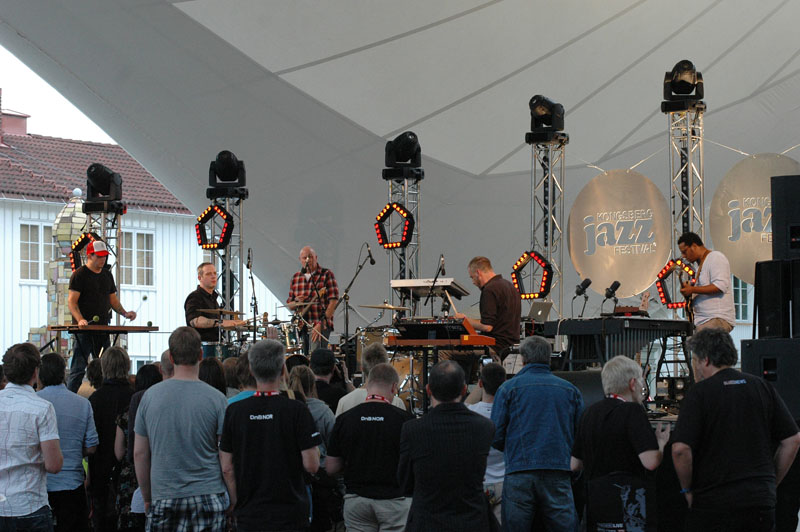 From left: John Herndon, Dan Bitney, Doug McCombs John McEntire, Jeff Parker
From left: John Herndon, Dan Bitney, Doug McCombs John McEntire, Jeff ParkerCombining elements of synth-heavy space rock, Kraut rock, dub, ambient and minimalism with Brazilian rhythms and a near endless variety of additional stylistic references, Tortoise live is, as King Crimson guitarist/co-founder Robert Fripp always describes his own group, a hot date as opposed to the love letter of its studio releases. In fact, outside of the hard-to-find box set, A Lazarus Taxon (Thrill Jockey, 2006), there's no documentation of the group in performance, and it's a shame, because as good as Beacons is (from which much of the group's set was culled), it really is a live act and deserves to be assessed as such.
A lot of groups are going the twin-drummer route these days, including guitarist Eivind Aarset, Jaga Jazzist trumpeter Mathias Eick with his own solo project, and progressive rocker Eddie Jobson's Ultimate Zero project. With three members of Tortoise drum-capable, there was muscular strength brought to songs like Beacons' opener, the groove-centric "High Class Slim Came In," along with vintage synths like John Herndon's Minimoog. Recent albums have also seen the group become more structurally focused, with generally shorter songs. Guitarist Jeff Parker, also playing synth during the set, brought jazz cred to the group when he joined for TNT (Thrill Jockey, 1998), helping make that album one of strongest in the group's 20-year run, but equally, the influence of Tortoise can be felt on his Chicago Underground Duo/Trio/Quartet albums. With a tone that harkened back to '70s funk—piercing treble, with wah wah pedal pushing it into a near screech at times—he sometimes seemed just on the verge of feedback as he played repetitive lines that worked hand-in-glove with bassist Doug McCombs.
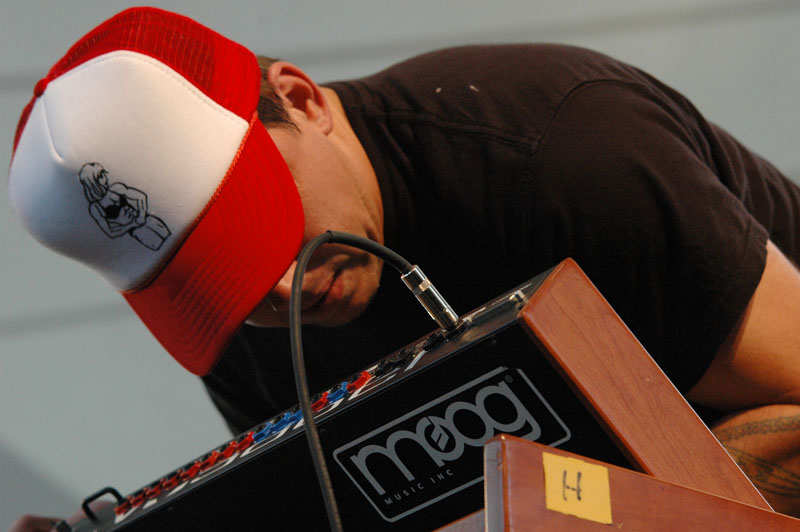 John Herndon
John HerndonDespite the sparse attendance, Tortoise put out as if it was in front of a crowd of thousands rather than a thousand at best. It may be twenty years old, but with a visceral energy that belies the advancing age of its players (with plenty of graying and recession on display), there's little doubt that Tortoise is just as relevant today as it was when McCombs and drummer/keyboardist/vibraphonist John Herndon first began jamming together in the late '80s.
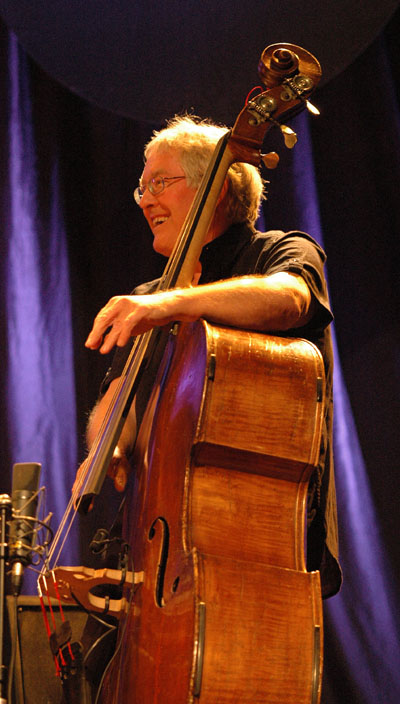 July 9: Jan Erik Vold / Arild Andersen / Bill Frisell
July 9: Jan Erik Vold / Arild Andersen / Bill Frisell While lesser-known outside Scandinavia, Jan Erik Vold is a poet who has forged his own unique place in jazz by collaborating with artists including Jan Garbarek, Arild Andersen, Bobo Stenson, Jon Christensen and Chet Baker. A series of recordings made with his Scandinavian friends in the 1970s has recently been released by Plastic Strip as Vokal—The Complete Recordings 1966-1977 (2010), a three-CD, one-DVD box set. With renewed attention on Vold's earlier work, putting a performance together at Kongsberg made a great deal of sense.
With Bill Frisell in Kongsberg, an even more unique opportunity arose, to not only reunite the guitarist with a bassist who figured prominently during his early days at ECM, but to do it in the context of a performance with Vold. After appearing on German bassist Eberhard Weber's Fluid Rustle ( 1979) and Norwegian bassist Arild Andersen's A Molde Concert (1982), ECM label head/producer Manfred Eicher approached Frisell with the idea of recording a solo album—his first under his own name. But the then-young Frisell, having been quickly thrust into the international spotlight, ran into some difficulties during the sessions, and so Eicher recruited Andersen to collaborate with the guitarist on five tracks that would ultimately become Frisell's first album as a leader, In Line (1983).
Walking onstage with Vold and Andersen for the trio's 10:30PM performance at the Kongsberg Kino (Cinema), years (decades) may have passed since Frisell and the bassist had worked together, but the time melted away almost immediately, as the guitarist began to layer simply lines over Andersen's looped harmonics. Andersen was one of the first musicians in Norway to employ looping, dating as far back as If You Look Far Enough (ECM, 1993), and his approach dovetailed perfectly with Frisell's to create backdrops that ranged from near-ambient evocations of Nordic landscapes to a swinging version of "Bye Bye Blackbird. The duo even reached right back to In Line, performing Frisell's "Shorts," a song that, in its original form, combined lyricism with a quirkily ascending line that led to what was, at the time, a strong indication of a voice that may still have had more promise on which to deliver, but was already surprisingly well-formed.
And what of Vold? Surprisingly, Vold did not use his own poetry as source material for his spoken word delivery. Instead, he read from a book of poetry that had finally been translated into Norwegian—American Modernist poet Wallace Stevens' The Emperor of Ice Cream. The title poem—as was the case with a number of the poems he read—was delivered mostly in Norwegian, but Vold did revert to English occasionally, oftentimes towards the end of the poem—was delivered over a swinging blues that Frisell and Andersen delivered with an appropriate sense of playful irony.
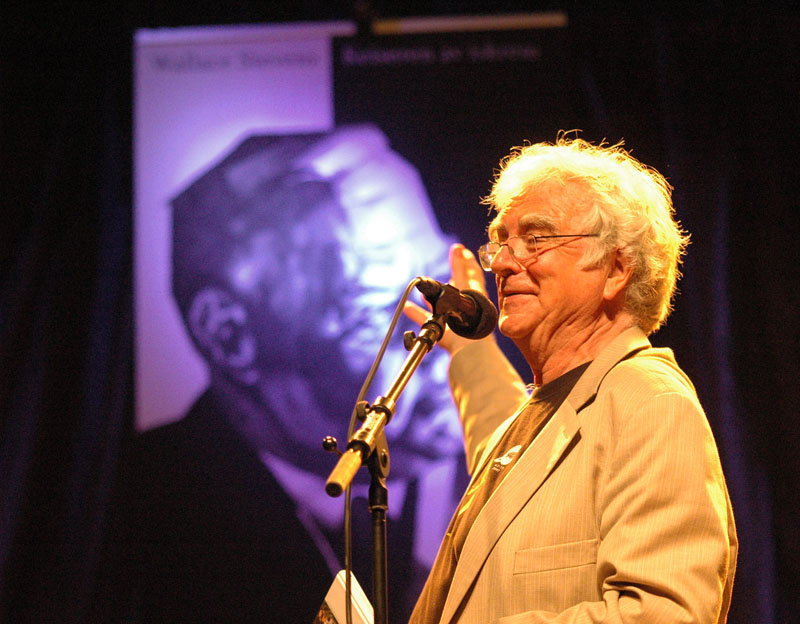 Jan Erik Vold
Jan Erik VoldSpoken word and jazz are hardly strangers to each other, but few can deliver poetry in a cadential way. Rinde Eickert did it successfully on drummer Jerry Granelli's Sandhills Reunion (Songlines, 2005), but that was Eckert reading his own words, and in the English language. What made Vold's performance with Frisell and Andersen, with smiles all around, so special was that even when Vold was delivering Wallace's poetry in Norwegian, it wasn't necessary to know what was being said to grasp the fundamental resonance. Between Vold's delivery, and the support of Frisell and Anderson, plenty was said without a single comprehensible word being spoken.
July 10: Public Interview with Håkon Kornstad and Martin Horntveth
For the final event at Silver City Sounds, AAJ was asked to conduct a public interview with saxophonist Håkon Kornstad and Jaga Jazzist drummer Martin Horntveth. Both were performing on the final day of the Kongsberg Jazz Festival, with Kornstad set to deliver an all-improvised set at Energimølla, along with bassist Skúli Sverrison and drummer John Hollenbeck, while Jaga Jazzist was set to perform the closing concert at Tubaloon.
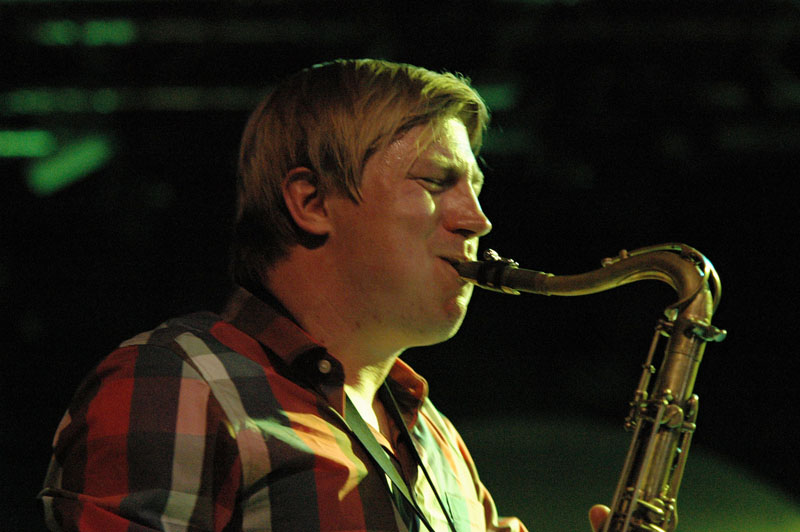 Håkon Kornstad
Håkon KornstadFirst coming to attention with Wibutee—a group that Kornstad described as marrying his jazz interests with pop artists like Björk. He has released two duo discs with pianist Håvard Wiik, a trio disc with bassist Mats Eilertsen and drummer Paal Nilssen-Love, and was a member of Maryland, along with pianist Maria Kannegaard, bassist Ole Morten Vågan and drummer Håkon Mjaset Johanssen. He also participated in keyboardist Bugge Wesseltoft's Jazzland Community—a tour and album that brought together a number of the label's more important artists for tours that not only covered parts of Europe, but North America as well.
Recently, he's been involved in a duo with singer Sidsel Endresen, but most important have been his two Jazzland albums, Single Engine (2007), and the remarkable Dwell Time (2009), recorded without overdubs in an Oslo Church in the winter of 2009. One of 2009's best releases, Dwell Time is a consolidation of Kornstad's ongoing innovations of the past several years, combining a variety of honed extended techniques, curious instrumental hybrids, and a seamless integration of technology to turn the act of solo performances into something far more orchestral, defying all logic.
Coming up at about the same time as Kornstad, the path taken by Martin Horntveth could be any more dissimilar. Drummer, multi-instrumentalist and de facto spokesperson for Jaga Jazzist— a group that first came together in the mid-1990s but gained international attention with the release of A Living Room Hush (Ninja Tune) in 2001—Horntveth is also one-third of the sibling trifecta that's at the core of Jaga Jazzist. The group started in 1994, with brother/multi-instrumentalist/composer Lars, and sister/ multi-instrumentalist Line.
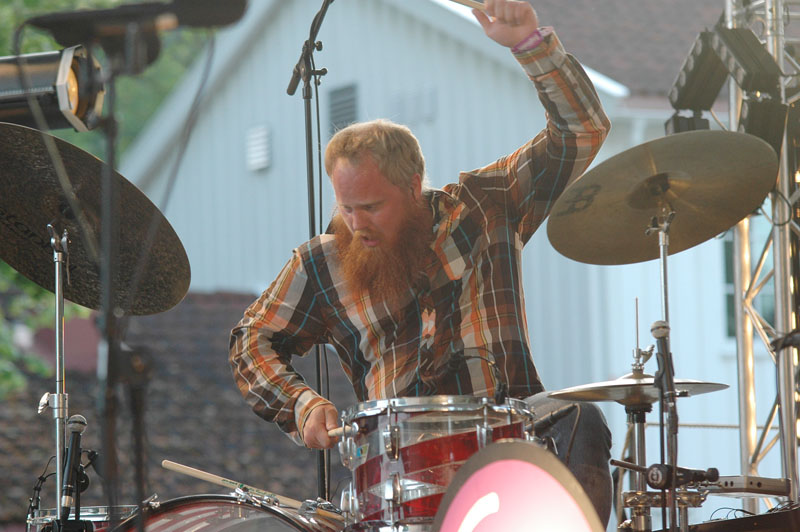 Martin Horntveth
Martin HorntvethJaga Jazzist has had a number of members come and go over the years, but has also served as the launching pad for Shining multi-instrumentalist Jørgen Munkeby; trumpeter Mathias Eick, whose 2008 ECM debut, The Door, has been well-received internationally; multi-instrumentalist Andreas Mjøs, also a producer working with groups like In The Country; keyboardist Øystein Moen, a charter member of improvising trio Puma; and guitarist Stian Westerhus who, in addition to working with Moen in Puma, has released the groundbreaking solo guitar album Pitch Black Star Spangled (Rune Grammofon, 2010).
Looking at a Jaga Jazzist stage is a bit like being in a music store—drums, bass, guitars, keys, saxophones, trumpet, tuba, trombone, flute, percussion, electronics, vibes...the list goes on. While Jaga Jazzist sound nothing like them, watching the group live is a bit like '70s progressive rock group, Gentle Giant, but also touches on the music of Tortoise, whose John McEntire finishing the mix of Jaga's latest release, One-Armed Bandit (Ninja Tune, 2010) when original producer, Jørgen Træen, had to retire from the album partway through, due to ill health.
The 45-minute interview touched on both artists' careers, including a few unexpected disclosures, including Kornstad's admission that, as a child, he sang as one of the Von Trapp Family in a production of The Sound of Music. Equally interesting was a discussion that tried to get into the big question of how a country with such a small population can have such a rich, vibrant and innovative music scene. Issues including money, educational emphasis and community were all raised, but it was SCS participant Bo Gronningaeter who raised the point that, unlike Denmark, for example, where North American jazz musicians emigrated in the 1950s onwards, until the 1960s Norway was not a particularly attractive place to live, and with no real grounding in the American tradition that has, in some ways, hobbled the developed of new music in Denmark until relatively recently, with artists like guitarist Jakob Bro, Norway has had to find its own tradition.
It made for an interesting wrap-up to the Silver City Sounds daytime activities, and a good segue into the evening's performances.
July 10: Håkon Kornstad / Skúli Sverrison / John Hollenbeck
Meeting in New York City during one of Kornstad's stays—up until recently, he was spending half his year there, the other half in Oslo—the saxophonist did a gig at The Stone with bassist Skúli Sverrison and drummer John Hollenbeck that went so well that, as Kornstad explained, "I said, 'next time I book the gig.'" And so, Hollenbeck—in addition to a number of large ensemble recordings including A Blessing (OmniTone, 2005), has led the remarkable Claudia Quintet for the better part of a decade, heard most recently on Royal Toast (Cuneiform, 2010)—and Sverrisson, a leader as well with albums including the recent Sería (Tónar, 2006), joined Kornstad for a late afternoon performance at Energimølla. It was the same room where Shining blew the roof off three days earlier, but this time, with concert-style seating, Kornstad, Sverrisson and Hollenbeck created a different kind of compelling dynamic.
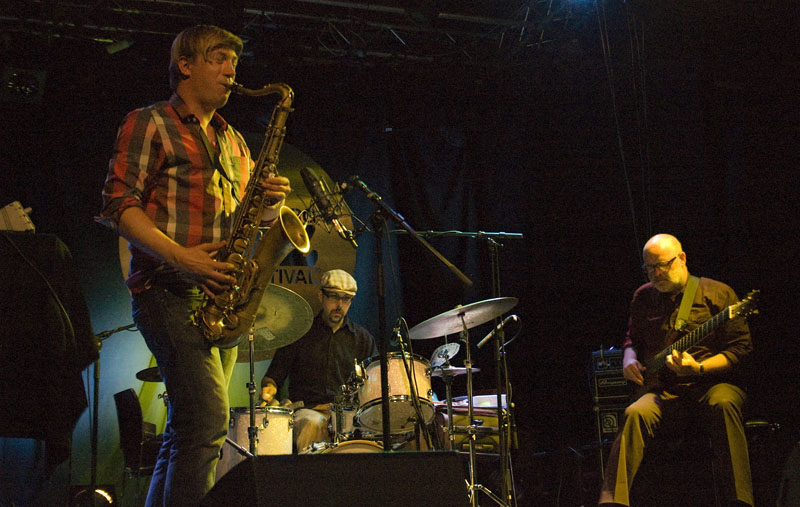 From left: Håkon Kornstad, John Hollenbeck, Skúli Sverrison
From left: Håkon Kornstad, John Hollenbeck, Skúli SverrisonKornstad's use of a looping device to build dense layers of sound was perfectly matched with Sverrisson, who also employed a variety of effects processors to create massive washes of sound. Playing a six-string electric bass, Sverrisson spent more time picking, strumming or, by tapping the body of his guitar, vibrating the strings of his bass, fed through reverb and delay units. Watching Kornstad and Sverrisson build a veritable wall of sound over the course of a 45-minute opening improvisation was a study in spontaneous composition, as the music ebbed and flowed with surprising shape and structure.
Kornstad's use of extended acoustic techniques only provided further source material for his looping device, as he create sharp percussive sounds through the mouthpiece, but also generated clicking sounds with nothing more than the pads of his keys. His use of consonant multiphonics also created harmonic movement within his gradually evolving layers of sound, all in response to or encouragement of Sverrisson's own extended bass techniques.
Hollenbeck may have been all acoustic, but he had his own array of additional hand percussion, a small megaphone that he used in the second half of the opening improv, and an overall approach that balanced texture and pulse. It's great to hear Hollenbeck in such an open-ended improvisational context, since much of his own work revolves around his strong compositional voice. At the start of the first improv, he created a buzzing percussion instrument reminiscent of the late Collin Walcott's handmade instrument on "Buzzbox," the transcendent opening improv on Oregon's In Performance (Elektra/Asylum, 1980).
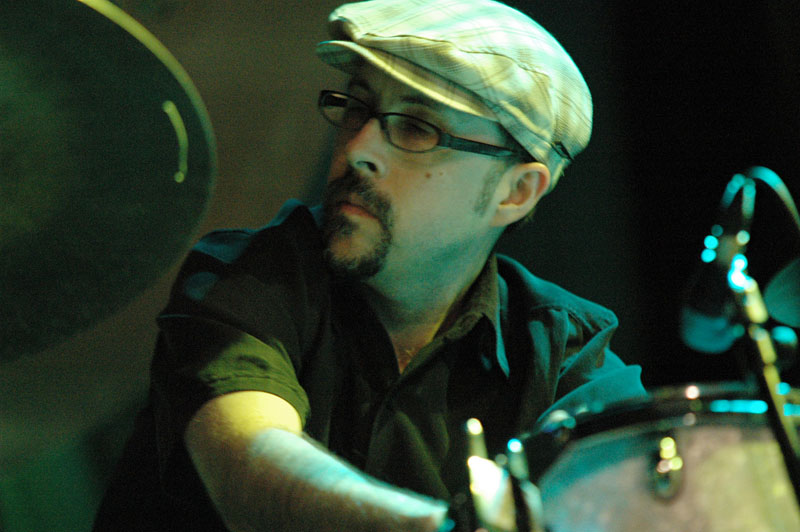 John Hollenbeck
John HollenbeckKornstad also used his flutonette, an instrumental hybrid that placed a clarinet mouthpiece on a flute body. Mixing and matching instruments is something else that seems to be a Norwegian innovation, with artists like Arve Henriksen placing a saxophone mouthpiece on his trumpet, as he did at his 2006 Punkt Festival performance. There's a certain fearlessness that seems to imbue the Norwegian mindset, one that, rather than quickly dismissing an outlandish idea, instead looks for some way to make it happen. It's this kind of intrepid exploration that has seen Kornstad emerge as one of the country's most forward-thinking improvisers, since he began to focus more on smaller, improv-heavy musical contexts. An adventurous spirit that, partnered with Sverrisson and Hollenbeck, will surely stand out as one of the festival's best all-improvised performances.
July 10: Jaga Jazzist
While there's little to link Jaga Jazzist with American guitar icon Pat Metheny, there is one place where the two do meet: Jaga Jazzist's music may be a crazy hybrid of jazz, electronica, minimalist influences and far more, but the high volume, rock-edged delivery is also reflected in its setup. Beyond the fact that the group has more instruments on stage than a small music store, there are props to go along with the slot machine cover of its latest release, One-Armed Bandit. A tour bus and van arrived at Tubaloon at 3:00PM for a two-hour setup, to meet the 5:00PM sound check deadline. A bevy of bodies carted road cases onto the stage, and the various stage dressings—lemons, melons, cherries, a bar sign and more—were positioned around the stage, along with additional lighting to augment that provided by the venue.
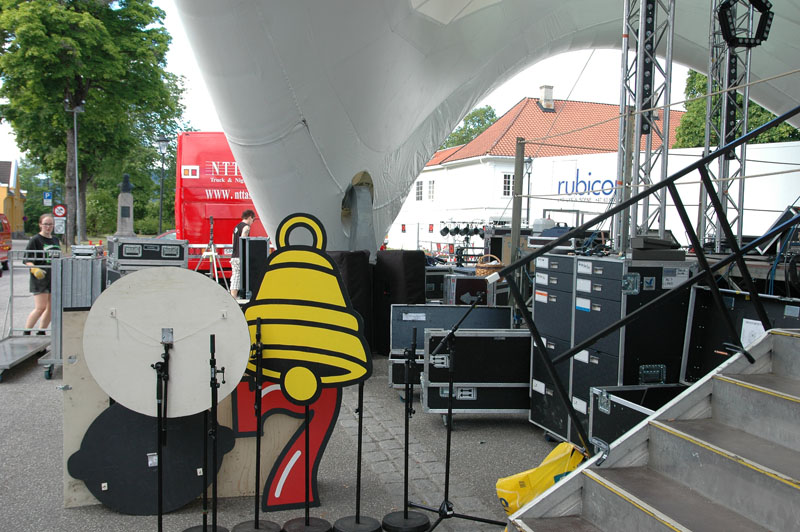 Load In
Load InWatching the various members of the group arrive, and hang out back of the house that's used as a backstage for the group, it's truly like watching a group of friends come together. In addition to the three Horntveth siblings that make up the core of Jaga Jazzist—drummer Martin (a multi-instrumentalist, in fact, but live restricting himself to a massive, striped, plexi-glass drum kit), brother Lars (main composer and a serious multi-instrumentalist who plays, at any given gig, saxophones, bass clarinet, guitar, lap steel guitar, vibraphone and keyboards) and sister Line (who, in addition to tuba, plays keyboards, xylophone, percussion and contributes wordless vocals)—there are two other members who have been with the group since inception, and others who have clocked in many years with the group. But there are invariably new members as well, and the most recent recruit is guitarist Marcus Forgsren, who replaced the departing Stian Westerhus a few months back.
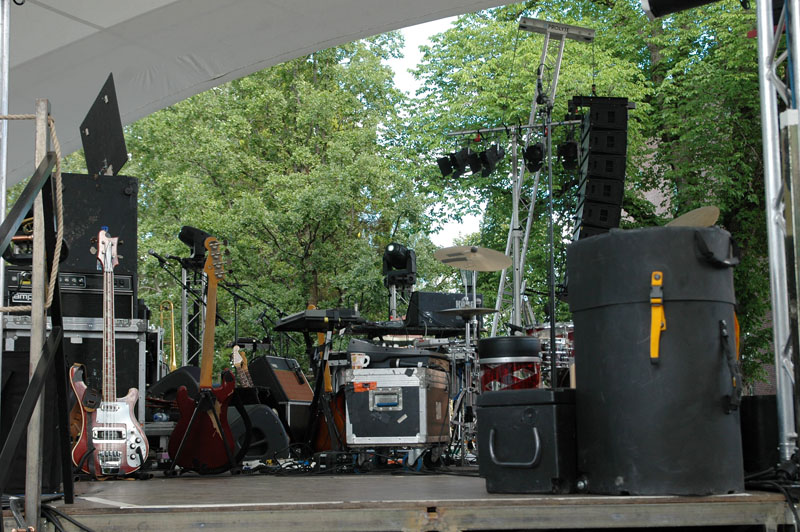 Set Up
Set UpThere's a lot to catch up on when Jaga Jazzist gets together for a tour. With nine members (currently one short of its usual ten), everyone works in a number of bands, but Jaga remains a priority made all the more remarkable since, with such a large ensemble and an equipment rider that would put most rock bands to shame, Jaga is not exactly a group that makes a living for its players. Still, it's not hard to understand why people remain so committed to the group. Lars Horntveth's writing may leave little improvisational space on record—and only a little more in concert—but it's tremendously rigorous, challenging music that, despite its detailed structure, comes alive in concert in ways that it simply cannot on record, no matter how good records like One-Armed Bandit, What We Must (2005) and The Stix (2003) unequivocally are.
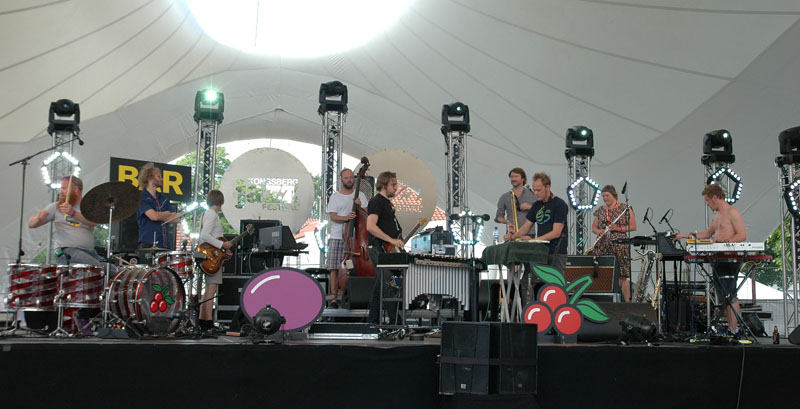 Sound Check
Sound CheckOne thing becomes immediately clear, both from talking to Martin Horntveth and listening to the sound check: Jaga Jazzist is loud. Martin plays in a number of bands (even a Bruce Springsteen tribute band where brother Lars puts on a red suit and takes on the role of Clarence Clemons; a joke in itself since Horntveth lacks "The Big Man"'s girth), but with Jaga, despite having to navigate shifting bar lines, staggering stops and starts, and tempo shifts, Martin plays with a kind of thundering power where John Bonham meets Billy Cobham. And there's a lot to check at a Jaga Jazzist sound check, what with a need to organize nine separate monitor mixes with a seemingly countless number of musical instruments—some shared, making creating individual mixes all the more challenging.
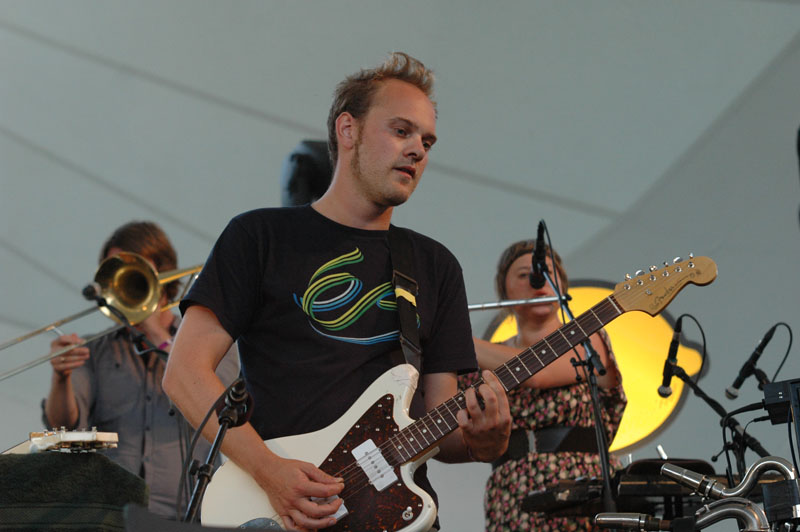 Lars Horntveth
Lars HorntvethBut it all managed to come together, and when Jaga hit the stage at 9:00PM, everyone in the group hit the ground running. The group focused heavily on music from One-Armed Bandit, though there was no shortage of earlier material, including "All I Know is Tonight" and "Oslo Skyline" (here, renamed "Kongsberg Skyline") from What We Must. The sound out front was not as good as it was when the group played at the indoor venue at Molde, in 2009; with a hard asphalt surface making up the grounds and all kinds of buildings surrounding Tubaloon on which the sound could bounce, the clarity of the instruments was sometimes lost. But what was lost in sound quality was more than made up for in energy. Song like "Toccata" (described by Martin as "Steve Reich meets Bernard Hermann") on new life as the swirling counterpoint of horns, vibraphone, bass, guitars, keyboards were pushed harder than on the record.
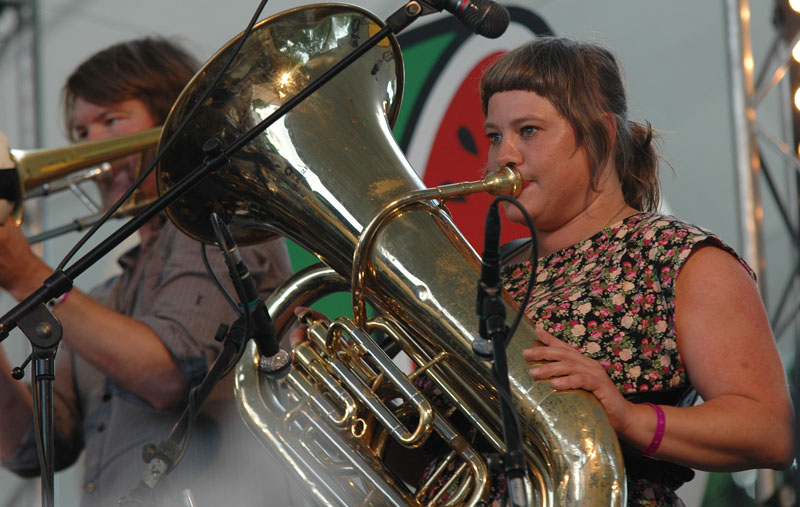 Line Horntveth (background left: Erik Johannessen)
Line Horntveth (background left: Erik Johannessen)All three Hornveth siblings commands attention in different ways. Martin, the spokesperson for the group, is a charismatic performer with a tremendous red beard, a hulking presence and perhaps the most directly connected player with the audience, despite facing inwards to the group, more often than not facing out and sometimes making direct eye contact (or, at least, seeming to). Lars' endless instrument shifts, even during the course of one song, links back yet again to Pat Metheny, who changes guitars as seamlessly as Lars moves from saxophone to bass clarinet, guitar, vibes and back again. Line, whose voice organically meshes with trombonist Erik Johannessen and trumpeter Mathias Eick (when, that is, Eick isn't playing double bass, vibes or keyboards), makes the tuba into an instrument that dances, while adding hand percussion to the mix and some trombone to boot.
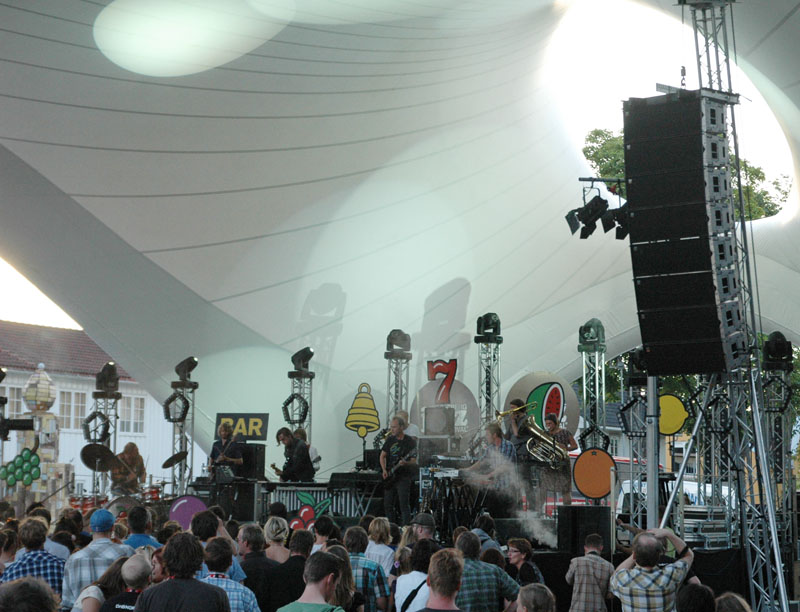 From left: Martin Horntveth, Even Ormestad, Andreas Mjøs, Marcus Forsgren Mathias Eick, Lars Horntveth, Øystein Moen, Erik Johannessen, Line Horntveth
From left: Martin Horntveth, Even Ormestad, Andreas Mjøs, Marcus Forsgren Mathias Eick, Lars Horntveth, Øystein Moen, Erik Johannessen, Line HorntvethBut everyone in the group manages to be in the spotlight at some point in the show, even though solo spots are rare (and short when they happen) and there's none of the usual feature spots for anyone. Instead, Jaga Jazzist is all about the writing, and performing it with stunning accuracy and heightened energy. The sound may not have been as good in the house as the group's 2009 return to live gigging at Molde Jazz 2009, after a five-year hiatus, but its performance was much, much better, the result of plenty of touring since that time. The good news is its show was being recorded—as are all of its current dates—for a planned live album to go along with the recently released Live at Cosmopolite (Ninja Tune, 2009), from a 2005 show in support of What We Must. With a new vinyl-only remix 12" EP, Bananfleur Overalt (Ninja Tune, 2010), and the regular release of free download tracks at the group's website, Jaga Jazzist is back with a vengeance, and working hard to keep up the momentum. After the show, Martin said that "two or three songs are good enough," not a bad number given the the number of shows already recorded, and ten more in the book between now and the end of the summer.
July 10: Kongsberg Ends
With a couple of late night concerts to round out the last day of the 2010 Kongsberg Jazz Festival, it was time to wrap things up and prepare for a week in Oslo. With all the hustle and bustle of the town during the festival's four days, it's hard to imagine that, by the following morning, almost everyone is gone and there are few signs that the festival had even taken place. With a successful program of music that encourages attendance from a broad demographic—and a youthful attendance that proves it is, indeed, possible to ensure that jazz doesn't fade away as aging baby boomers begin to hit their retirement years, festivals like Kongsberg provide a model from which North American jazz festivals—most facing the clear challenge of attracting people beyond the gray hairs and no hairs—could and should learn.
Visit Bill Frisell, Tortoise, Arild Andersen, Håkon Kornstad, John Hollenbeck, Jaga Jazzist and Kongsberg Jazz Festival on the web.
Coming Up: First Encounters in Oslo
Photo Credits
Page 1, Henie Onstad Arts Centre: Courtesy of Henie Onstad Arts Centre
All Other Photos: John Kelman
Part 1 | Part 2 | Part 3 | Part 4 | Part 5 | Part 6 | Part 7
Tags
PREVIOUS / NEXT
Support All About Jazz
 All About Jazz has been a pillar of jazz since 1995, championing it as an art form and, more importantly, supporting the musicians who make it. Our enduring commitment has made "AAJ" one of the most culturally important websites of its kind, read by hundreds of thousands of fans, musicians and industry figures every month.
All About Jazz has been a pillar of jazz since 1995, championing it as an art form and, more importantly, supporting the musicians who make it. Our enduring commitment has made "AAJ" one of the most culturally important websites of its kind, read by hundreds of thousands of fans, musicians and industry figures every month.


